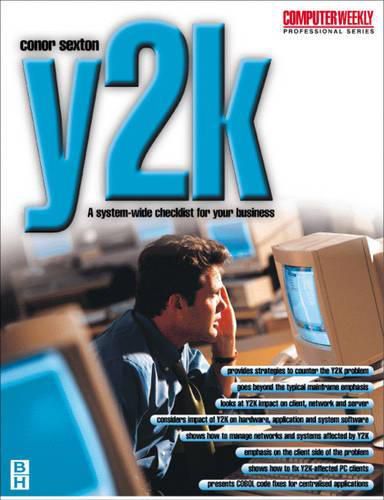Readings Newsletter
Become a Readings Member to make your shopping experience even easier.
Sign in or sign up for free!
You’re not far away from qualifying for FREE standard shipping within Australia
You’ve qualified for FREE standard shipping within Australia
The cart is loading…






* avoids the hype and ‘shock-horror’ of Y2K; instead provides strategies to counter the problem
* goes beyond the typical mainframe emphasis
* deals with the impact of Y2K on client, network and server
* considers impact of Y2K on hardware, application software and system software
* advises on how to manage networks and systems affected by Y2K
* emphasizes the client side of the problem and how to fix Y2K-affected PC clients
* presents COBOL code fixes for centralized applications
This book is an overview for the technical manager of the ‘issues’ to be considered as part of implementing any Year 2000 (Y2K) repair project.
Even if your organization is small - you are not running a large bank and you do not own a mainframe - the fact that you use PCs to keep it running means that the Y2K problem affects you, too. Use this book as a checklist of the Y2K issues you should at least be thinking about.
This book is deliberately short. In seven chapters, Conor Sexton covers the essence of the Y2K problem and measures that should be adopted to fix it. In giving emphasis to the distributed client/server computing model, as well as the traditional mainframe home of the Y2K problem, the concerns of small businesses as well as major enterprises are addressed. In addressing Year 2000, this book consciously leans towards the kind of distributed client/server computing environment, heavily reliant on PCs, found in most large and small businesses today.
Conor Sexton is an independent systems consultant. He runs his company, Trigraph Software Research, from Dublin, Ireland. He has had six previous books published under the Butterworth-Heinemann, Newnes and Made Simple imprints; these have dealt with the COBOL, C and C++ programming languages, as well as client/server technologies. Conor has more than 20 years’ experience of all aspects of software design, programming, project management and systems implementation. He is currently engaged mostly with Amdahl and IBM, where he specializes in large-scale systems management and Y2K-related development projects. He has in recent years led, and had extensive hands-on involvement with, a number of major projects in these areas on behalf of major European financial and industrial enterprises. He brings this experience of total project implementation to this book. avoids the hype and ‘shock-horror’ of Y2K; instead provides strategies to counter the problem deals with the impact of Y2K on client, network and server
considers impact of Y2K on hardware, application software and system software
$9.00 standard shipping within Australia
FREE standard shipping within Australia for orders over $100.00
Express & International shipping calculated at checkout
* avoids the hype and ‘shock-horror’ of Y2K; instead provides strategies to counter the problem
* goes beyond the typical mainframe emphasis
* deals with the impact of Y2K on client, network and server
* considers impact of Y2K on hardware, application software and system software
* advises on how to manage networks and systems affected by Y2K
* emphasizes the client side of the problem and how to fix Y2K-affected PC clients
* presents COBOL code fixes for centralized applications
This book is an overview for the technical manager of the ‘issues’ to be considered as part of implementing any Year 2000 (Y2K) repair project.
Even if your organization is small - you are not running a large bank and you do not own a mainframe - the fact that you use PCs to keep it running means that the Y2K problem affects you, too. Use this book as a checklist of the Y2K issues you should at least be thinking about.
This book is deliberately short. In seven chapters, Conor Sexton covers the essence of the Y2K problem and measures that should be adopted to fix it. In giving emphasis to the distributed client/server computing model, as well as the traditional mainframe home of the Y2K problem, the concerns of small businesses as well as major enterprises are addressed. In addressing Year 2000, this book consciously leans towards the kind of distributed client/server computing environment, heavily reliant on PCs, found in most large and small businesses today.
Conor Sexton is an independent systems consultant. He runs his company, Trigraph Software Research, from Dublin, Ireland. He has had six previous books published under the Butterworth-Heinemann, Newnes and Made Simple imprints; these have dealt with the COBOL, C and C++ programming languages, as well as client/server technologies. Conor has more than 20 years’ experience of all aspects of software design, programming, project management and systems implementation. He is currently engaged mostly with Amdahl and IBM, where he specializes in large-scale systems management and Y2K-related development projects. He has in recent years led, and had extensive hands-on involvement with, a number of major projects in these areas on behalf of major European financial and industrial enterprises. He brings this experience of total project implementation to this book. avoids the hype and ‘shock-horror’ of Y2K; instead provides strategies to counter the problem deals with the impact of Y2K on client, network and server
considers impact of Y2K on hardware, application software and system software